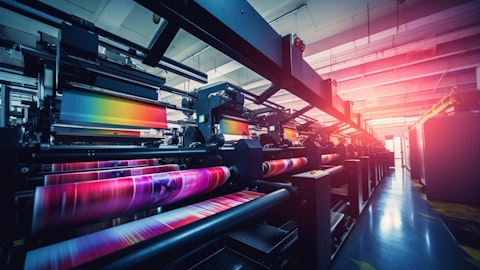But unlike last year, we did not have a drop in the low-margin equipment sales. Throughout the year, we kept a tight leash on cost in light of softer sales, reap the benefits of lower depreciation costs that reduced our equipment purchases on on-site services. And even higher labor costs associated with increase in scanning and revenue and inflationary pressures were not enough to put a dent on our gross margin. SG&A for the year was down, benefiting from a lower level of sales commissions and bonuses, which left us with net income and earnings per share relatively stable year-over-year. The decrease in adjusted EBITDA for the year was attributed to our lower sales and an increase in labor costs. While cash flow from operations was affected by the same things, the decrease was mitigated by strong cash collection efforts in the second half of the year.
Our DSO dropped a full four days, which helped keep 2023 cash flow from operations in line with prior year and drove the $2.9 million increase in the fourth quarter. We are happy to report that for the full year, we returned $12 million to shareholders in the form of dividend and share buyback. This was the most we have ever done in the history of the company, and we plan to do it again in 2024. Our liquidity and capital structure continues to improve, even after the $12 million spent on shareholder returns. Our cash balance decreased by $3.5 million. Our net debt was only $6 million, representing a $7.7 million decrease. Our leverage ratio stands at only 0.3 adjusted EBITDA. Finally, before we end our remarks, we need to address the obvious outlier on our P&L for the year, the site remediation expense.
The expense stems from an acquisition we made in California during the 1990s that include a property that have been used for a gas station before we purchased it. The gas station had long been demolished and its storage tax removed well before our involvement. Several years ago, ground monitoring detected petroleum on the property, and we were asked to create a remediation plan for this site. We did so, and the plan was approved. But further monitoring in the fourth quarter of 2023 turned up additional risk and now required a much more extensive plan. Three points are worth emphasizing about this expense. First, none of this has to do with our operations. Second, this is the only service center property we own. And third, and most importantly, this expense will extend over a long period of time, but accounting rules require us to establish reliability now.
We don’t expect it to hamper our operations or our cash flows in a meaningful way in any given year of the project. Turning our attention to 2024. We are seeing encouraging growth in our strategic services, and our pipeline of opportunities and backlog is robust. The economy is benefiting from anticipated declines in interest rates, and the variety of industries and customers we serve continues to grow. We’ve also made prudent investments in people, marketing and equipment to drive future growth. With that in mind, we look forward to what lies ahead in 2024 and sharing our progress with you in the coming quarters. At this point, I’ll turn the call back to Suri. Suri?
Kumarakulasingam Suriyakumar: Thank you, Jorge. Operator, we are now ready for questions from our listeners.
Operator: Thank you. [Operator Instructions] We’ll go to Greg Burns, Sidoti & Company.
Gregory Burns: Good afternoon. In the construction plan printing market, I guess, you noted you saw some signs of stabilization in the fourth quarter. As you look into ’24, I know interest rates going down would be a potential catalyst to get that part of the business higher. But do you — barring interest rates going down, do you feel like that business has stabilized at a lower level? How should we think about the potential for further declines in that side of the business?
Kumarakulasingam Suriyakumar: Yeah. Like you said, Greg, if actually the interest rates go down, it’s definitely going to kickstart some of the construction business, and it will be helpful for the plan printing segment of our revenues. However, if the interest rates don’t move, which I think is unlikely, probably it’s going to be stable, and it’s going to just be muted. I don’t think it’s going to do any different. Dilo, would you agree?
Dilantha Wijesuriya: No, I agree, Suri. And I’m thinking the other thing to do is, even if the interest rates go down in the second quarter, it’s going to depend always at a six to nine month lag to see new designs, new construction put into place. So I just wanted to keep that timing in mind as well.
Operator: And we will move to our next question.
Dilantha Wijesuriya: Hang on. Greg, did you have another question?
Gregory Burns: Yeah. Sure. Just one more around your capital allocation priorities. I guess, if the cash flow remains strong this year, you’ll probably be in a net cash position. What are your thoughts on maybe increasing the dividend or accelerating buybacks? How do you think about the capitalization and share return for the business?
Kumarakulasingam Suriyakumar: Yeah. Both of those opportunities, Greg. I mean, obviously, based on everything that we did last year, which was an amazing year from a shareholder returns point of view, I mean, I was talking to Jorge, 33% of our cash flow from operations went back to the shareholders. How good is that? So I mean — so that — it’s already pretty good. And if it continues to improve, then of course, depending on the market conditions, we will decide what to do as to whether we should buy back more shares or how we deploy that cash. Cost of operating the business is also going up. So it’s something that we want to bear in mind. We might choose to make some investments in the business. Jorge, would you like to add to that?



